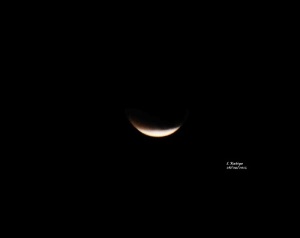Home » Posts tagged 'Supermoon'
Tag Archives: Supermoon
Supermoon over Morden Wharf by L. Katiyo
Photo L. Katiyo
The Isle of Dogs is a remarkable place, however it is probably not the place to scan the skies due to the amount of artificial light.
Photo L. Katiyo
On Sunday and Monday, many Islanders were looking into the skies for the appearance of the Supermoon which in this particular case is when the moon appears 14% larger and 30% brighter than normal.
This was considered quite a special Supermoon due the fact that the moon will come closer to Earth than at any other time since 1948 being only 221,524 miles (356,509km) away.
Photo L. Katiyo
It was considered that Monday evening would be the best chance to see the Supermoon in the UK, unfortunately the cloud cover over London disappointed many skygazers.
Photo L. Katiyo
One skygazer who took a few photographs on Sunday was Isle of Dogs Life’s regular contributor L. Katiyo who trained her camera over Morden Wharf to capture the rare astronomical event.
Photo L. Katiyo
If like me, you missed the event, do not despair because the moon will get even closer on 25th November 2034 when the moon will be within 221,485 miles.
Supermoon over the Isle of Dogs by L. Katiyo – 28th September 2015
The Isle of Dogs is not usually the best place to go sky watching, the bright lights often obscure the night sky. However, if you are near the river you can often get wonderful views of the sunrises and sunsets.
Not expecting to get a great view of the ‘ Supermoon ‘, I did not join the skywatcher’s hoping to get a view of quite a rare astronomical occurrence.
One of the skywatchers was L. Katiyo one of the regular contributors to this site and her persistence paid off with a series of wonderful pictures.
The moon’s unusual appearance in its supermoon state is the result of a rare coincidence. It appears larger than usual because it is at its lowest point in its orbit around the Earth, while its reddish tint is the result of an eclipse.
When a lunar eclipse coincides with the moon at its lowest point in its orbit it creates the “supermoon” or sometimes called Blood Moon.
The eclipse which made the Moon appear red was visible in North America, South America, West Africa and Western Europe. This phenomenon was last observed in 1982 and will not be back before 2033.
From the UK, skywatchers watched the Moon pass through the Earth’s shadow in the early hours of Monday morning.
The eclipse began at 00:11 GMT, when the Moon entered the lightest part of the Earth’s shadow. At 02:11 GMT the Moon completely entered-the inner dark part of our planet’s shadow.
The point of greatest eclipse occurred at 02:47 GMT, when the Moon was closest to the centre and the eclipse ending at 05:22 GMT.
In a total lunar eclipse, the Earth, Sun and Moon are almost exactly in line and the Moon is on the opposite side of the Earth from the Sun.

As the full Moon moves into our planet’s shadow, it dims but usually remains visible, lit by sunlight that passes through the Earth’s atmosphere.

The Moon takes an orbit around Earth, which means that its average distance changes from as far as 405,000km (its apogee) to as close as 363,000km at (the perigee).
So now we know what why the Supermoon is such a rare celestial occurrence and for those of us who are still around in 2033, it may be worth forgoing a good night’s sleep to view the event.
Many thanks to Laureen for the photographs taken from the Isle of Dogs.











